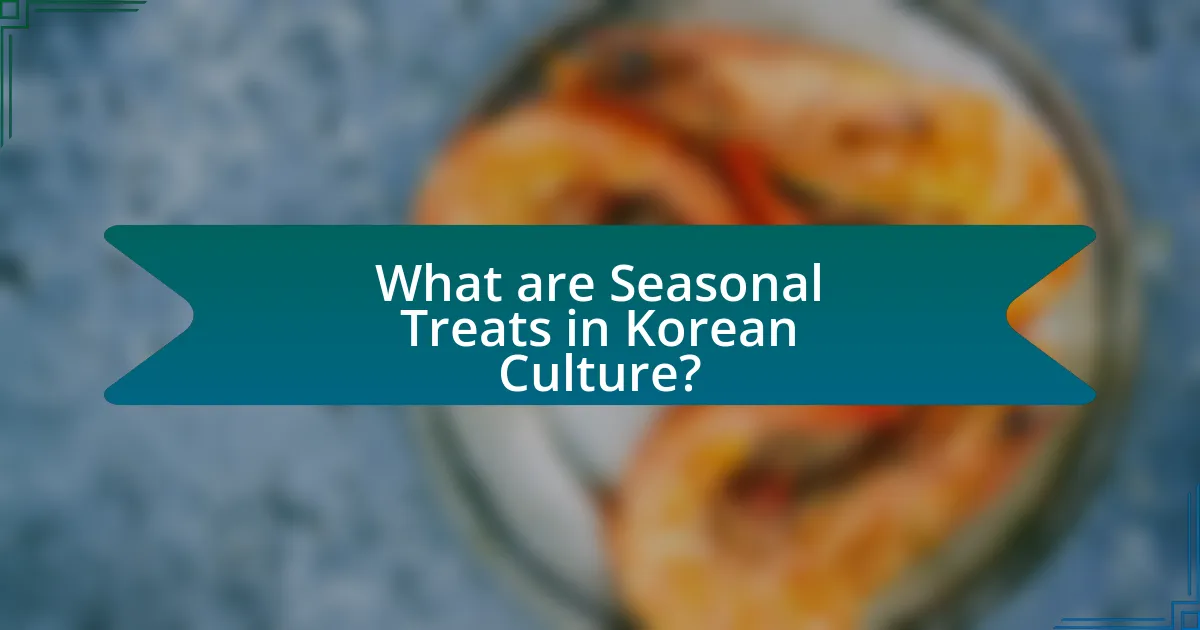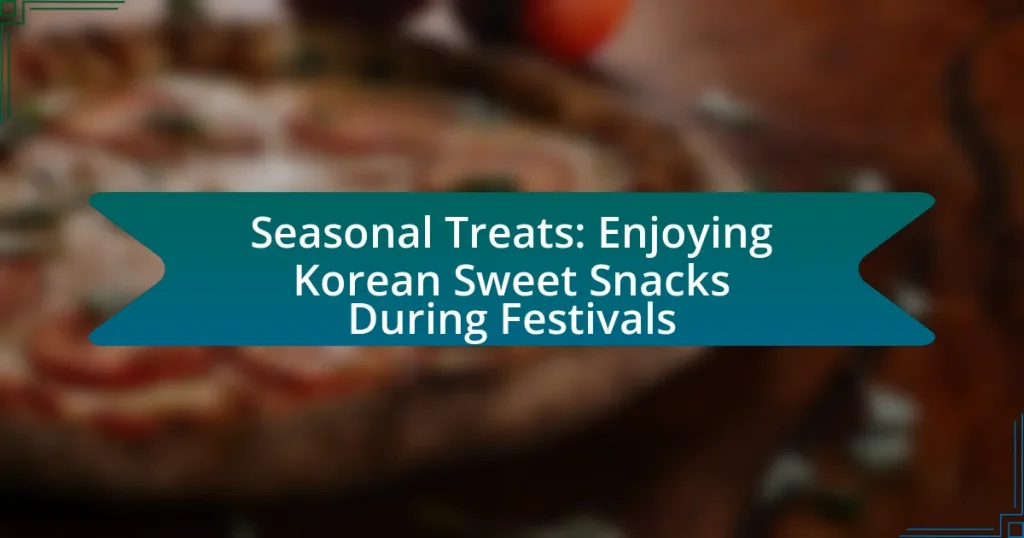Seasonal treats in Korean culture, such as songpyeon and baekseolgi, play a significant role during festivals like Chuseok and Seollal, reflecting the country’s agricultural heritage and communal values. These traditional snacks are often made with locally sourced ingredients, symbolizing gratitude for the harvest and fostering family bonds. The article explores the cultural significance of these treats, their preparation methods, and the regional variations that influence their flavors and textures. Additionally, it provides insights into the importance of sweet snacks in celebrations, their role in family gatherings, and practical tips for enjoying and making these treats at home.

What are Seasonal Treats in Korean Culture?
Seasonal treats in Korean culture include a variety of traditional snacks that are enjoyed during specific festivals and seasons. Notable examples are songpyeon, a rice cake filled with sweetened sesame or red bean paste, typically made during the Chuseok harvest festival, and baekseolgi, a steamed white cake often served at celebrations like birthdays. These treats not only reflect the agricultural calendar but also embody cultural significance, as they are often prepared and shared among families, reinforcing communal bonds and traditions.
How do seasonal treats reflect Korean traditions?
Seasonal treats in Korea, such as songpyeon during Chuseok and baekseolgi for celebrations, reflect the country’s agricultural heritage and cultural values. These treats are often made with locally sourced ingredients, symbolizing gratitude for the harvest and the importance of family gatherings. For instance, songpyeon, a rice cake filled with sweetened sesame or red bean paste, is traditionally prepared by families to honor ancestors, showcasing the deep-rooted respect for lineage and community. Additionally, the vibrant colors and shapes of these treats often represent seasonal changes and the beauty of nature, reinforcing the connection between food and the cyclical rhythms of life in Korean culture.
What festivals are most associated with Korean sweet snacks?
The festivals most associated with Korean sweet snacks are Chuseok and Seollal. Chuseok, also known as the Korean harvest festival, features traditional sweets like songpyeon, a rice cake filled with sweetened sesame or red bean paste. Seollal, the Lunar New Year celebration, includes sweets such as tteokguk, a rice cake soup that symbolizes the gaining of a year in age. Both festivals highlight the importance of sweet snacks in Korean culture, serving as offerings and symbols of prosperity and family unity.
How do seasonal ingredients influence the types of treats made?
Seasonal ingredients significantly influence the types of treats made by dictating flavor profiles, textures, and cultural significance. For instance, in Korea, ingredients like fresh fruits in summer or chestnuts in autumn are commonly used in traditional sweets, resulting in treats that reflect the season’s bounty. The use of seasonal ingredients not only enhances the taste but also aligns with cultural practices, as certain treats are prepared during specific festivals to celebrate the harvest or seasonal changes, such as songpyeon during Chuseok, which incorporates seasonal rice and fillings. This connection between ingredients and seasonal festivities underscores the importance of local produce in shaping culinary traditions.
Why are sweet snacks important during festivals?
Sweet snacks are important during festivals because they symbolize celebration and community bonding. In many cultures, including Korean traditions, sweet treats are often prepared and shared among family and friends to mark special occasions, enhancing the festive atmosphere. For instance, during Chuseok, a major harvest festival in Korea, families prepare and enjoy traditional sweets like songpyeon, which are rice cakes filled with sweetened sesame or red bean paste, representing gratitude and abundance. This practice not only fosters social connections but also preserves cultural heritage, as these snacks often carry historical significance and are passed down through generations.
What role do they play in family and community gatherings?
Korean sweet snacks play a central role in family and community gatherings during festivals by serving as symbols of celebration and togetherness. These treats, such as songpyeon and baekseolgi, are often prepared and shared among family members, reinforcing bonds and traditions. For instance, during Chuseok, families gather to make songpyeon, which represents gratitude for the harvest and is a way to honor ancestors. This communal preparation and sharing of snacks not only enhances the festive atmosphere but also preserves cultural heritage, as these practices are passed down through generations.
How do they symbolize prosperity and good fortune?
Korean sweet snacks symbolize prosperity and good fortune through their traditional associations with festivals and rituals. These treats, often made with ingredients like rice, beans, and nuts, are believed to bring blessings and abundance during celebrations such as Chuseok and Seollal. For example, songpyeon, a type of rice cake filled with sweetened sesame or mung bean paste, is specifically prepared during Chuseok to honor ancestors and ensure a bountiful harvest, reinforcing the connection between these snacks and the hope for future prosperity.

What are the Most Popular Korean Sweet Snacks During Festivals?
The most popular Korean sweet snacks during festivals include songpyeon, baekseolgi, and yakgwa. Songpyeon, a rice cake filled with sweetened sesame or red bean paste, is traditionally made during Chuseok, the harvest festival, symbolizing gratitude for the harvest. Baekseolgi, a fluffy steamed cake, is often served at celebrations like birthdays and is made with glutinous rice flour, giving it a light texture. Yakgwa, a honey cookie made from wheat flour and sesame oil, is commonly enjoyed during various holidays, including the Lunar New Year, and is known for its rich flavor and sweetness. These snacks are integral to Korean culture, reflecting the significance of festivals in celebrating seasonal changes and family gatherings.
What types of sweet snacks are commonly enjoyed?
Commonly enjoyed sweet snacks include rice cakes, known as “tteok,” which are often made with glutinous rice and filled with sweetened red bean paste or other fillings. Additionally, “hotteok,” a type of filled pancake, is popular for its sweet, syrupy center. “Bungeoppang,” fish-shaped pastries filled with sweet red bean paste, are also favored. These snacks are traditionally enjoyed during Korean festivals, highlighting their cultural significance and popularity among locals and visitors alike.
How is Songpyeon prepared and served during Chuseok?
Songpyeon is prepared by mixing glutinous rice flour with water to form a dough, which is then filled with sweetened ingredients like sesame seeds, red beans, or chestnuts. The filled dough is shaped into half-moons and steamed over a bed of pine needles, which impart a fragrant aroma. During Chuseok, Songpyeon is served on a special table set for ancestral rites, symbolizing gratitude for the harvest and the hope for a good year ahead. This traditional practice emphasizes the cultural significance of Songpyeon as a seasonal treat enjoyed during the festival.
What makes Ddeok a staple during celebrations?
Ddeok is a staple during celebrations due to its symbolic significance and cultural importance in Korean traditions. This rice cake represents prosperity, good fortune, and the marking of special occasions, such as birthdays and holidays. Historically, Ddeok has been used in rituals and ceremonies, reinforcing its role in communal gatherings and festive events. For instance, during the celebration of Chuseok, a major harvest festival, Ddeok is prepared and shared among families to honor ancestors and express gratitude for the harvest. This practice highlights the deep-rooted connection between Ddeok and the celebration of life events in Korean culture.
How do regional variations affect sweet snacks?
Regional variations significantly influence sweet snacks by incorporating local ingredients, flavors, and cultural traditions. In Korea, for example, regional specialties like Songpyeon, a rice cake filled with sweetened sesame or red bean paste, are traditionally made during the Chuseok festival, reflecting the agricultural practices and seasonal harvests of specific areas. Additionally, regions may emphasize different textures and presentations, such as the use of glutinous rice in the Jeolla province versus the more diverse fillings found in the Gyeongsang province. These variations not only cater to local tastes but also preserve cultural heritage, as seen in the distinct recipes passed down through generations, showcasing the importance of regional identity in the enjoyment of sweet snacks during festivals.
What unique treats are found in different provinces?
In South Korea, unique treats vary by province, reflecting local ingredients and traditions. For example, in Jeonju, the famous Jeonju bibimbap includes a sweet twist with its use of seasonal vegetables and gochujang, while in Gyeongju, the traditional rice cake known as “baekseolgi” is often enjoyed during festivals. Additionally, in Busan, “sikhye,” a sweet rice drink, is popular during celebrations. Each of these treats showcases the regional flavors and cultural significance tied to local festivals, highlighting the diversity of Korean cuisine across provinces.
How do local ingredients shape these variations?
Local ingredients significantly shape variations in Korean sweet snacks during festivals by influencing flavor profiles, textures, and cultural significance. For instance, the use of seasonal fruits like persimmons and chestnuts not only enhances the taste but also reflects the harvest cycle, making the snacks more relevant to the time of year. Additionally, regional specialties, such as Jeju Island’s tangerines, contribute unique flavors that distinguish local variations from one another. This connection to local agriculture fosters a sense of community and tradition, as families often prepare these snacks using ingredients sourced from their surroundings, reinforcing cultural identity during festive celebrations.

How Can You Enjoy Korean Sweet Snacks at Home?
To enjoy Korean sweet snacks at home, you can prepare traditional recipes such as tteok (rice cakes), hotteok (sweet pancakes), or bungeoppang (fish-shaped pastries). These snacks are often made with ingredients like glutinous rice flour, sugar, and various fillings such as red bean paste or nuts. Preparing these snacks allows you to experience authentic flavors and textures associated with Korean festivals, where such treats are commonly enjoyed. For instance, tteok is traditionally consumed during celebrations like Chuseok, the Korean harvest festival, highlighting its cultural significance.
What are some easy recipes for traditional snacks?
Some easy recipes for traditional Korean snacks include making rice cakes, known as “tteok,” and sweet red bean paste pancakes, called “bungeoppang.” Tteok can be prepared by steaming glutinous rice flour mixed with water and sugar, then shaping it into small cakes. Bungeoppang involves mixing flour, sugar, and water to create a batter, which is then filled with sweet red bean paste and cooked in a fish-shaped mold. These recipes are simple and reflect the cultural significance of these snacks during Korean festivals, where they are commonly enjoyed.
How can you make homemade Songpyeon?
To make homemade Songpyeon, combine glutinous rice flour with water to form a dough, then shape it into small discs. Fill each disc with a mixture of sweetened sesame seeds or red bean paste, fold them over, and pinch the edges to seal. Steam the filled dumplings for about 20 minutes until they become translucent. This traditional Korean rice cake is often enjoyed during the Chuseok festival, symbolizing gratitude for the harvest. The use of glutinous rice flour is essential, as it gives Songpyeon its characteristic chewy texture.
What tips are there for perfecting Ddeok?
To perfect Ddeok, focus on using high-quality glutinous rice flour and ensuring proper steaming techniques. High-quality flour contributes to the texture and flavor, while steaming at the right temperature and duration prevents the Ddeok from becoming too dry or too sticky. Additionally, incorporating natural ingredients like red bean paste or seasonal fruits enhances the taste and authenticity of the Ddeok. Consistent practice and attention to detail in measurements and cooking times will lead to improved results.
What are the best practices for serving and enjoying these treats?
The best practices for serving and enjoying Korean sweet snacks during festivals include presenting them on decorative platters and pairing them with traditional beverages like tea. Decorative platters enhance the visual appeal, making the treats more inviting, while pairing with tea complements the flavors and provides a cultural context. Additionally, serving these snacks at room temperature ensures optimal taste and texture, as many Korean sweets are best enjoyed fresh. It is also customary to share these treats among family and friends, fostering a sense of community and celebration during festivals.
How can you pair sweet snacks with traditional beverages?
Pair sweet snacks with traditional beverages by considering complementary flavors and textures. For example, pairing sweet rice cakes (tteok) with traditional Korean tea, such as omija-cha (five-flavor tea), enhances the experience as the tartness of the tea balances the sweetness of the rice cakes. Additionally, pairing honeyed pastries like yakgwa with sujeonggwa (cinnamon punch) creates a harmonious blend, as the spice in the punch complements the rich, sweet flavors of the pastries. This approach is supported by cultural practices in Korea, where specific snacks and beverages are traditionally enjoyed together during festivals, enhancing the overall sensory experience.
What presentation tips enhance the festive experience?
To enhance the festive experience, visually appealing presentation of Korean sweet snacks is essential. Utilizing vibrant colors and traditional serving dishes can create an inviting atmosphere that reflects the cultural significance of the snacks. For instance, arranging the treats in a circular pattern on a decorative platter not only showcases the variety but also symbolizes unity and celebration, which are key themes during festivals. Additionally, incorporating seasonal elements, such as flowers or themed decorations, can further elevate the presentation, making it more festive and engaging for guests.
What are some common challenges when making Korean sweet snacks?
Common challenges when making Korean sweet snacks include achieving the right texture, balancing flavors, and mastering traditional techniques. The texture is crucial, as many snacks like tteok require precise rice flour ratios and steaming times to ensure they are chewy yet soft. Balancing flavors can be difficult, especially when incorporating ingredients like red bean paste or sweeteners, which need to complement rather than overpower the dish. Additionally, mastering traditional techniques, such as kneading and shaping, often requires practice and experience, making it challenging for beginners. These factors contribute to the complexity of creating authentic Korean sweet snacks.
How can you troubleshoot issues with texture and flavor?
To troubleshoot issues with texture and flavor in Korean sweet snacks, first identify the specific problem, such as graininess, sogginess, or lack of sweetness. For graininess, ensure that ingredients like glutinous rice flour are finely ground and properly cooked, as improper texture often results from inadequate grinding or cooking time. If the snack is too soggy, check the moisture content and cooking time; reducing liquid ingredients or increasing cooking time can help achieve the desired texture. For flavor issues, taste the mixture before final cooking; adjust sweetness by adding sugar or honey incrementally, as traditional recipes often require precise measurements for balance. These troubleshooting steps are supported by culinary principles that emphasize ingredient quality and cooking techniques, ensuring that the final product meets the expected standards of texture and flavor in Korean sweet snacks.
What resources are available for learning more about these treats?
Books, websites, and cooking classes are valuable resources for learning about Korean sweet snacks during festivals. Notable books include “Korean Home Cooking” by Sohui Kim, which provides recipes and cultural context for traditional treats. Websites like Maangchi.com offer detailed recipes and video tutorials specifically focused on Korean cuisine, including seasonal snacks. Additionally, local cooking schools often provide classes on Korean cooking, allowing hands-on experience with these festive treats. These resources collectively enhance understanding and appreciation of Korean sweet snacks.


